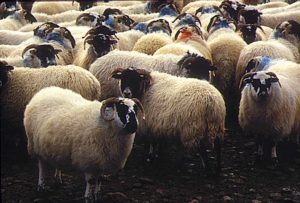Thin Ewes, What Is The Cause?
18 October 2017 In the run up to the main tupping season checking ewe body condition score (BCS) and considering the impact that disease may be having on it is an important part of flock health planning. In addition 2017 rainfall data points to a high risk of liver fluke this autumn. Ewes below BCS 3 it is possible to increase body condition by a whole score in 8 weeks. This is conditional on them being provided with the best quality grass at a minimum height of 4cm. One of the main reasons for them not achieving this weight gain under such conditions may be disease. Therefore, grazing lean ewes in this way and assessing their response to improved nutrition is a useful first screening test to assess likely disease risk.
In the run up to the main tupping season checking ewe body condition score (BCS) and considering the impact that disease may be having on it is an important part of flock health planning. In addition 2017 rainfall data points to a high risk of liver fluke this autumn. Ewes below BCS 3 it is possible to increase body condition by a whole score in 8 weeks. This is conditional on them being provided with the best quality grass at a minimum height of 4cm. One of the main reasons for them not achieving this weight gain under such conditions may be disease. Therefore, grazing lean ewes in this way and assessing their response to improved nutrition is a useful first screening test to assess likely disease risk.
Another key question to consider is: Are the thin ewes an individual, small group or large group problem?
The principal diagnoses are as follows:
Individual Problems: Neoplasia, arthritis, endocarditis, scrapie, chronic pneumonia, CLA
Small group problems: Poor dentition, Johne’s disease, OPA, Maedi Visna, PGE
Large group problems: Inadequate nutrition, liver fluke, sheep scab, foot rot and CODD
We would suggest that submitting representative thin ewes that are not fit for sale for euthanasia and post mortem may be the most effective way of reaching a diagnosis across the range of possible problems. The batch rate for up to 4 sheep is £89 plus carcass disposal which is a very cost effective way of making a diagnosis.
Heather Stevenson, healther.stevenson@sac.co.uk
Sign up to the FAS newsletter
Receive updates on news, events and publications from Scotland’s Farm Advisory Service
